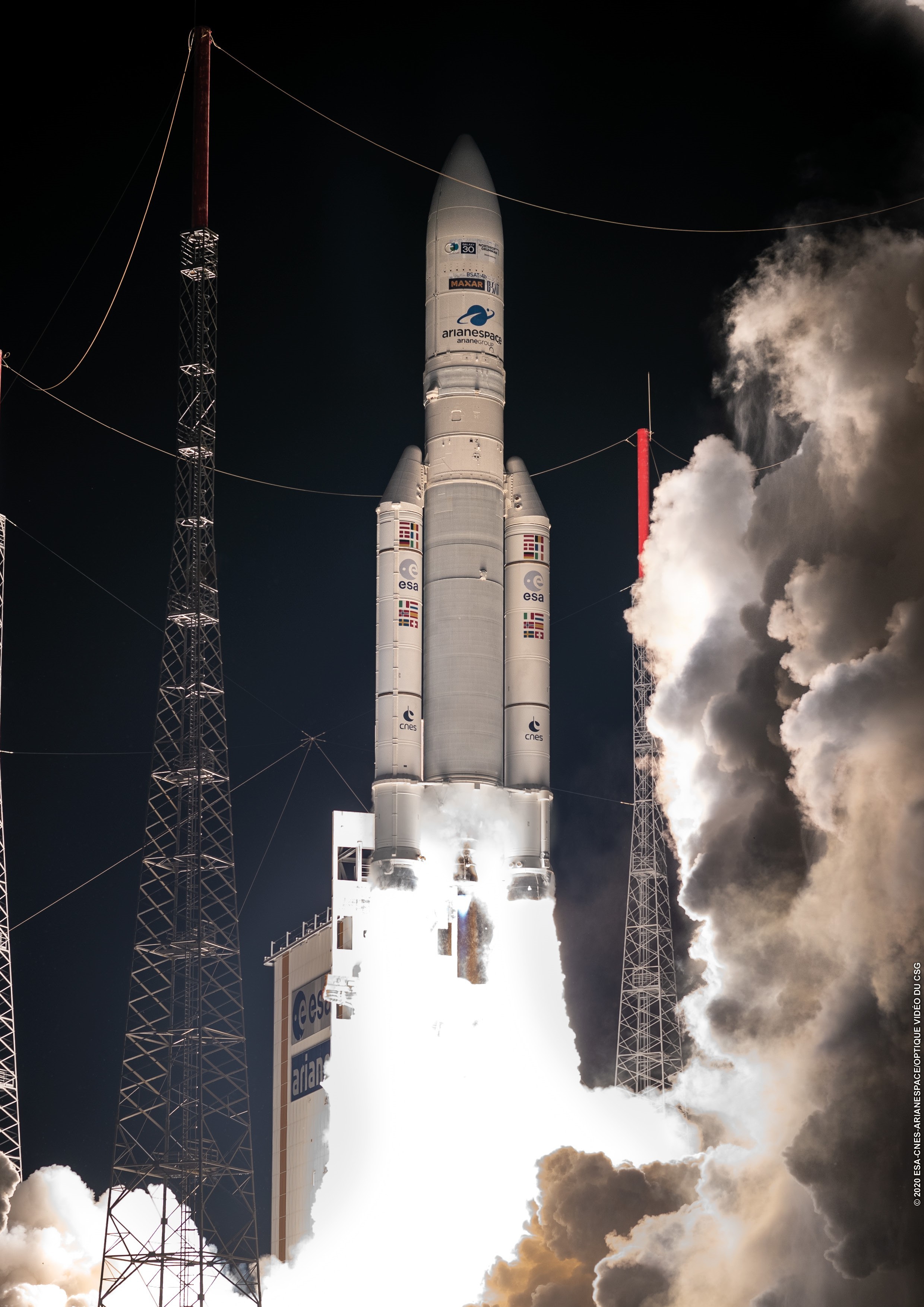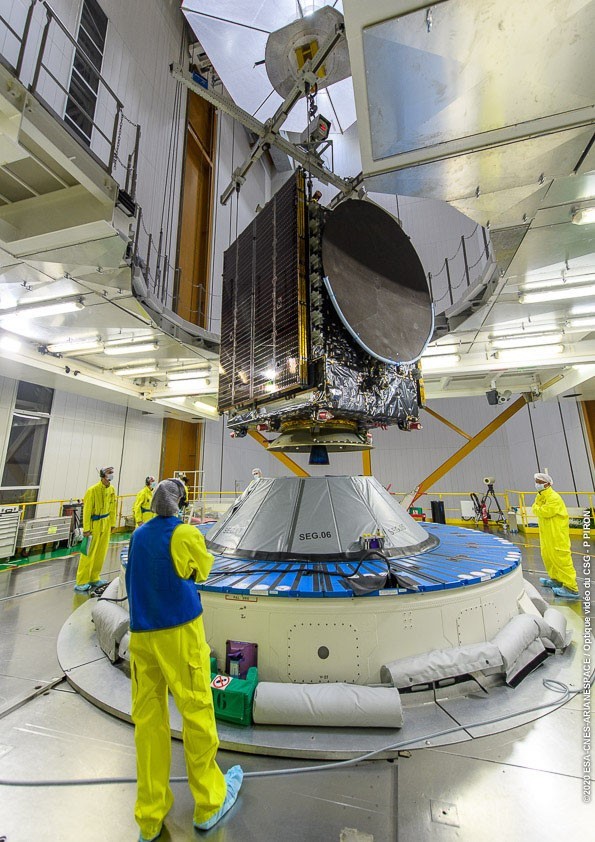We’re all familiar now with how the coronavirus is impacting every aspect of our daily lives, but it’s also influencing work that not many people get to experience in-person: strapping spacecraft on the top of rockets and safely launching them into space. This is an exciting process that requires a hands-on approach, just like in Maxar’s factory. Because of this, Maxar worked closely with Arianespace, our launch partner, to implement stringent COVID-19 health protocols equivalent to our Maxar policies. We further implemented strict protocols unique to the launch base campaign specific to international travel, housing and meals for the 22 Maxar team members during the entire trip. Maxar, Arianespace and B-SAT proceeded with the campaign only after we were convinced we could conduct it safely.
On Saturday, August 15, 2020, the Maxar-built BSAT-4b satellite caught a ride into space on the first Ariane 5 rocket to launch from the Arianespace launch base in Kourou, French Guiana since February 2020. The satellite, built for Broadcasting Satellite System Corporation (B-SAT), is performing according to plan, and it is currently undergoing in-orbit testing before reaching its final geosynchronous orbit at 110 degrees East longitude.

Image courtesy Arianespace.
Maxar, B-SAT and Arianespace had to devise unique solutions to avoid spreading the coronavirus amongst its mission personnel who had to be on-site to complete launch-related tasks and the team members who would have typically celebrated the launch together.
Team members at the launch base
As a first step, Maxar reduced the number of employees who traveled to French Guiana to strictly essential personnel to prepare BSAT-4b for its launch. Even though these employees were being careful about possible exposure to the virus before the trip, one Maxar mechanical technician had to go into quarantine and miss the trip after encountering someone who tested positive for COVID-19, which speaks to the unpredictable nature of this virus.
French Guiana imposed a mandatory one-week quarantine on anyone arriving in the country. While Maxar employees would typically arrive a day or so before the satellite, this time around they spent a week in a hotel before the satellite landed at Félix Eboué Airport near the capital city of Cayenne, French Guiana.

As BSAT-4b arrived in French Guiana on July 1, 2020, the receiving crew had to wear masks and maintain social distances. Image courtesy Arianespace.
As the team prepped the satellite to be placed on top of the Ariane 5, they had to wear masks and maintain social distance while working together.

Arianespace and Maxar crews wear masks and stay apart while integrating BSAT-4b on the launch vehicle on July 18, 2020. Image courtesy Arianespace.
While the Ariane 5 was due to launch at the end of July, a series of delays meant the launch crew was in French Guiana for about two weeks longer than expected. They made the most of it by enjoying a few BBQs at the hotel, even though the pool was closed.
Now, the launch base team has returned to California where they quarantined for two weeks. Overall, they spent 8 weeks (56 days) away from their families including quarantine at launch base working on giving BSAT-4b a safe ride to space.

Team members at Maxar’s Mission Control Center
During any launch of a Maxar-built spacecraft, the company’s Mission Control Center (MCC) in Palo Alto, Calif., is staffed and ready to begin the spacecraft’s operations. During the BSAT-4b launch, the workstations were separated so there were only two per row instead of three. This caused some workstations to be moved into adjacent rooms to accommodate the space needed (photo below).

During a pre-coronavirus launch, the customer would have employees in the MCC to participate in starting the satellite’s operations. For BSAT-4b, Maxar established remote connections so that B-SAT employees could access the MCC from Japan and not risk traveling and catching the virus.
Once the spacecraft is in orbit, Maxar typically sends employees to Australia to perform testing from Gnangara Station. Instead, that crew is now completing the testing remotely from California to avoid additional risks of spreading or catching the coronavirus.
Celebrating the launch virtually
The standard on-site launch experience for the customers and manufacturers usually starts with a mission briefing that details how the spacecraft was made and what it will do once in service. After attending that in-person briefing, the guests go to a launch viewing area near the launch pad.
For BSAT-4b, Maxar sponsored a virtual launch experience that Arianespace organized for the VIP guests instead of hosting an in-person celebration. Maxar’s Executive Program Director for BSAT-4b, Leslie Chavolla, gave the mission briefing and answered questions virtually over video-conferencing while in the MCC in California (photo below).

After the mission briefing, guests were moved in a virtual 3D rendering of Arianespace’s Jupiter room, which is where the guests would have watched the launch had they been on site. A chat function in the virtual experience allowed the guests to interact with each other, which encouraged a sense of community even though they could not be physically together.

It’s also typical during the launch broadcast to conduct live, in-person interviews. Maxar’s Paul Estey, Advisor to the CEO on Space, recorded his interview from California via Skype while the host was in Paris.

To wrap up the virtual launch experience, representatives from B-SAT, Arianespace and Maxar gathered on Zoom to raise a glass in celebration from Japan, Paris, Colorado, California and Washington, D.C. It was the next-best way to celebrate a major accomplishment since everyone couldn’t be together.

Despite COVID-19 causing the entire world to change the way they behave, we at Maxar are continuing to serve our customers with timely deliveries of spacecraft and creating actionable Earth Intelligence at scale. BSAT-4b is the seventh commercial spacecraft we’ve delivered for launch this year. We strive to continue business as usual while facing unique challenges – and launches are a prime example of how to find a suitable solution while protecting our team members, customers and partners.